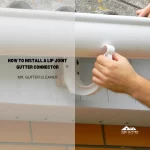Gutter problems, ranging from clogs to leaks, pose significant risks to a home’s structure and safety.
These issues, often overlooked, can lead to costly repairs if not addressed promptly. Clogged gutters, resulting from leaves, debris, and standing water, prevent proper water flow, causing overflow and potential foundation damage.
Leaks and holes in gutters, stemming from corrosion or physical damage, compromise the system’s integrity, allowing water to damage the home’s exterior and interior walls.
Improperly installed or sagging gutters fail to direct water away effectively, leading to erosion and landscaping damage.
In areas with heavy snowfall, the added weight can detach gutters from the home.
Recognizing signs of wear and implementing regular maintenance schedules are crucial steps in preventing these common gutter issues.
By understanding and acting upon the first signs of gutter problems, homeowners can protect their investment and ensure their home remains safe from water-related damage.
What Causes Gutter Problems?
Gutter problems stem from various sources, including environmental factors, physical damage, and lack of maintenance. Weather conditions like heavy rain, snow, and ice can lead to clogs and sagging, while debris such as leaves, twigs, and sediment can block water flow, causing overflows and water damage. Improper installation or the use of subpar materials can also contribute to gutter issues, affecting their longevity and effectiveness. Regular inspection and maintenance are crucial to identifying and addressing these problems early, preventing more severe damage to the home’s structure and foundation.
How Do Weather Conditions Affect Gutters?
Weather conditions significantly impact gutters, with heavy rain causing clogs and snow leading to sagging from weight. Temperature fluctuations can also cause gutters to expand and contract, leading to cracks and separations over time.
The Impact of Improper Installation on Gutter Performance
Improperly installed gutters fail to manage water flow efficiently, leading to overflows and damage. Incorrect slope and spacing can prevent water from draining, causing backups and potential structural damage to the property.
Can Trees and Debris Lead to Gutter Issues?
Trees and debris are primary culprits in gutter blockages, with leaves, branches, and sediment obstructing water flow. This accumulation not only causes clogs but also invites rust and pests, compromising gutter integrity.
Identifying Common Gutter Issues
Common gutter issues include clogs, leaks, sagging, and detachment from the house. Clogs are often caused by debris accumulation, preventing water from flowing freely. Leaks and holes may develop due to corrosion or damage, leading to water escaping and potentially damaging the home’s exterior and foundation. Sagging gutters, which can result from the weight of debris, water, or ice, may eventually pull away from the house if not promptly addressed. Identifying these issues early through regular inspections can help homeowners take timely action to mitigate potential damage.
What Are the Signs of Clogged Gutters?
Signs of clogged gutters include visible debris, water spillover during rain, and sagging. Gardens or pools of water forming at the base of the house also indicate blockages, leading to potential foundation issues.
How to Spot Gutter Leaks and Overflows?
Gutter leaks and overflows manifest as water marks or damage on the siding, peeling paint, or erosion around the house. Persistent dampness in areas below gutters can signal a leak or overflow problem.
Symptoms of Gutter Sagging and Detachment
Gutter sagging and detachment are visible as gaps between the gutters and the roofline or gutters hanging off the side of the house. This often results from the weight of debris, ice, or improper installation.
The Consequences of Neglecting Gutter Maintenance
Neglecting gutter maintenance can lead to several significant problems for a homeowner. Blocked or damaged gutters can cause water to overflow, leading to soil erosion, damaged landscaping, and weakened foundations. Over time, water infiltration can also cause exterior and interior wall damage, mold growth, and basement flooding. Additionally, stagnant water in gutters can attract pests, including mosquitoes, rodents, and birds, creating health hazards and potential infestations. Regular maintenance is essential to prevent these issues and ensure the gutter system functions correctly.
How Do Gutter Problems Affect Your Home’s Foundation?
Gutter issues can lead to foundation damage by allowing water to pool around the base of the house. This water can cause cracks and settling, leading to costly repairs and structural instability.
The Link Between Faulty Gutters and Water Damage
Faulty gutters contribute to water damage by failing to direct rainwater away from the home. This can result in water intrusion, damaging walls, ceilings, and floors, and can lead to mold and mildew growth.
Can Ignored Gutter Issues Lead to Pest Infestations?
Neglected gutter problems often create habitats for pests such as mosquitoes, rodents, and insects. Standing water in clogged gutters provides a breeding ground for mosquitoes, while debris can attract rodents seeking shelter.
Preventative Measures and Solutions
Preventative measures for gutter maintenance include regular cleaning, installation of gutter guards, and periodic inspections to identify potential problems. Cleaning gutters at least twice a year, in the spring and fall, helps prevent clogs and ensures proper water flow. Gutter guards can significantly reduce the amount of debris entering the gutters, decreasing the need for frequent cleanings. Additionally, inspecting gutters for signs of damage, such as cracks, rust, and sagging, allows homeowners to make necessary repairs before issues worsen. Implementing these preventative measures can extend the life of gutter systems and protect the home from water-related damage.
Regular Cleaning and Maintenance: How Often and How?
Regular gutter cleaning and maintenance should occur at least twice a year, typically in spring and autumn, to prevent clogs and damage. Proper maintenance includes removing debris, flushing gutters with water, and checking for any signs of wear or damage.
The Role of Gutter Guards in Preventing Clogs
Gutter guards play a crucial role in preventing debris from entering the gutters, thereby reducing the likelihood of clogs. They come in various types, such as mesh screens, foam inserts, and surface tension units, each suitable for different needs and budgets.
When and Why to Consider Gutter Replacement
Gutter replacement becomes necessary when repairs are no longer cost-effective or when gutters continuously fail, causing damage to the home. Upgrading to more durable materials or better-suited designs for the local climate can significantly improve gutter performance.
Professional Help vs. DIY: Making the Right Choice
Deciding between professional gutter maintenance and DIY involves considering safety, convenience, and cost. DIY gutter maintenance can be cost-effective and satisfactory for those comfortable working on ladders and with the necessary tools. However, for complex issues, hard-to-reach areas, or homeowners not confident in their ability to safely perform the work, hiring a professional is advisable. Professionals have the expertise, tools, and insurance to safely and effectively address gutter issues, offering peace of mind and potentially saving money in the long run by preventing costly damage.
When Should You Hire a Professional for Gutter Maintenance?
Professional gutter maintenance is advisable for complex issues, high or hard-to-reach gutters, or when the homeowner lacks the tools or knowledge for safe and effective DIY maintenance.
Professionals can also offer valuable insights into preventative measures and potential upgrades.
DIY Gutter Maintenance: Tips and Tricks
For those opting for DIY gutter maintenance, safety is paramount. Use a stable ladder, wear gloves, and have a helper if possible.
Tools like a garden hose, gutter scoop, and bucket are essential for cleaning, while inspections should focus on signs of sagging, blockage, and wear.
How to Choose the Right Gutter Service Provider
Choosing the right gutter service provider involves checking for licensing, insurance, experience, and references. A reputable company should offer a detailed inspection, a clear explanation of the required work, and a written estimate.
Future-Proofing Your Gutters: Innovative Solutions
Future-proofing gutters involves adopting innovative solutions and technologies to enhance their efficiency and longevity. Seamless gutters reduce the risk of leaks, while materials like aluminum and copper offer durability and resistance to corrosion. Smart gutter systems, equipped with sensors and automated cleaning mechanisms, can drastically reduce maintenance needs. Additionally, incorporating rainwater harvesting systems not only alleviates strain on gutters during heavy rainfall but also promotes water conservation. By investing in these innovative solutions, homeowners can ensure their gutter systems are more effective, durable, and environmentally friendly.
The Advantages of Seamless Gutters Over Traditional Ones
Seamless gutters offer superior protection against leaks due to their continuous design, minimizing the joints where leaks most often occur. Made to measure on-site, they provide a perfect fit for any home, improving both function and aesthetic appeal.
Smart Gutter Technology: Is It Worth the Investment?
Investing in smart gutter technology, such as heated gutters and automated cleaning systems, can significantly reduce maintenance needs and prevent common problems like ice dams and blockages. While initially more expensive, the long-term savings in damage and cleaning costs can make them a worthwhile investment.
Environmental Considerations in Gutter Design
Eco-friendly gutter designs focus on sustainable materials and water conservation. Collecting and repurposing rainwater through integrated catchment systems not only reduces gutter problems but also contributes to a sustainable home environment by providing water for gardening and other uses.


